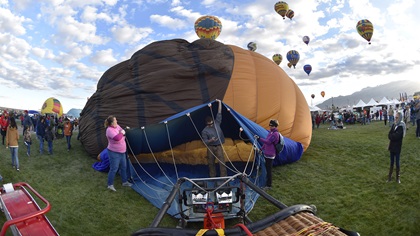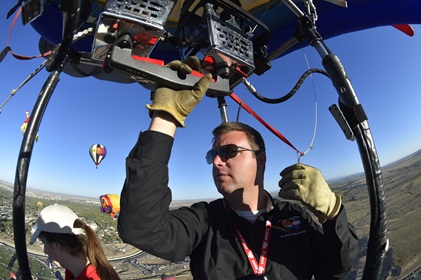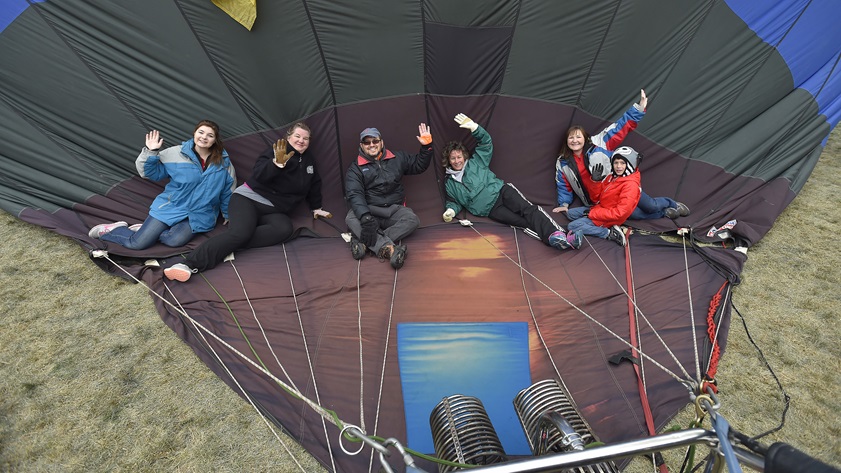Hot air ballooning could be a hot ticket
Aviation enthusiasts considering their flying options might be interested to learn that hot air ballooning could be their ticket to the sky. At the world’s largest lighter-than-air event in Albuquerque, New Mexico, experienced balloonist Colin Graham was peppered with questions from a curious crowd that gathered around the basket of his specially shaped Bud E. Beaver balloon like moths to a candle. “What’s it like to fly?” “Do you need a license?” “Why haven’t you launched yet?”
The 33-year-old repeated, “Awesome. Yes. Because the wind is too strong but we’re hoping for a green flag soon.”

One of the easiest ways to experience ballooning is to “attend a local hot air balloon festival, kind of check things out and see if you like it,” said Graham, as he inflated his traditionally shaped Wandering Endeavor balloon for an evening “Glowdeo.” Balloonists nearby blasted yellow flames into their aircraft in a symphony of sounds amid a kaleidoscope of color and shapes.
“Maybe take a flight with a local balloon ride operator, and from there you could join a crew” to experience different phases of flight, he said. “See what you think of it. Almost everybody starts as a crew member.” Graham told AOPA during the Albuquerque International Balloon Fiesta that, “Very, very few [balloon pilots] went crewless” before attaining their certificate. His wife, Brittany, a sign language interpreter, joined her sister Ashley Schultz and friends Chris Schafer, Tony Overton, and five others to spread out the flight envelope, rig lines, and carry gear.
Balloonists at the festival warned that experiencing the feeling of pure flight in a lighter-than-air device can become addictive. “It’s almost like you’re standing still and the earth leaves you,” said Graham. He recently earned his commercial certificate in a fixed-wing aircraft but said he preferred the simplicity and peacefulness of ballooning compared to the vibrating cacophony of powered flight.

Graham was drawn to the idea of flying hot air balloons after he experienced an up-close encounter with one. A balloon pilot softly floated to a landing near the family house in Georgia not far from Lawrenceville’s Gwinnett County Briscoe Field Airport when he was 8 years old.
“I learned how to pilot a balloon before I could drive a car,” said Graham, who is now a commercial balloon operator and has traveled the world with his balloons from Europe to Asia.
Thinking back to his routine as a student balloon pilot Graham said he soloed “a lot more than most people but that’s primarily because I didn’t have a regular instructor,” which, he explained, was not uncommon considering the relatively small number of balloonists compared to fixed-wing and rotorcraft pilots.
After finding his calling, Graham started a commercial balloon ride company at age 18 when the family moved to Virginia. He said flying in the foothills of the Appalachian Mountains was challenging as he built up his skills, his confidence, and his knowledge of weather and the microclimates that were essential for safe flight. Balloons lack rudders and elevators, so pilots rely on air currents to steer the devices, climbing or descending to catch favorable wind direction that points them where they want to go.
The family-friendly environment was another draw for Graham and many balloonists at the Albuquerque rally. After flights they tailgated in fields and enjoyed an atmosphere that allowed crew members of all ages and experience levels to help pilots launch, track, and pack the balloons.

Floating silently along above the Rio Grande River, Graham said that smelling the aroma of baked goods, hearing horses whinnying from a pasture, and waving to people on the ground were the calling cards of balloonists the world over.
“There really are no words to describe it,” Graham said, as he punched a blast of hot air that lifted his balloon into the bright blue sky.





